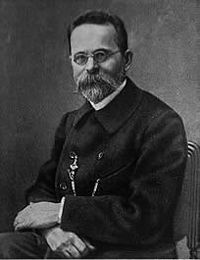- Nikolai Alexandrovich Morozov
-
Nikolai Alexandrovich Morozov (Никола́й Алекса́ндрович Моро́зов; July 7, 1854 – July 30, 1946) was a known Russian revolutionary who spent about 25 years in prison before turning his attention to various fields of science.
Contents
Revolutionary activities
The son of a landowner by a serf woman, Morozov was born in the village of Borok in the Yaroslavl Oblast of Russia. He early became interested in politics and was expelled from secondary school when he was accused of subversive activity (His distribution of a scientific magazine was considered subversive because Russian schools did not teach science ). He joined the Circle of Tchaikovsky before departing for Geneva in 1874. He later was a member of Zemlya i volya (co-editing their mouthpiece, Land and Liberty, with Sergei Kravchinsky) and one of the leaders of another revolutionist group, Narodnaya Volya, starting in 1879.
In 1880 Olga Liubatovich and Morozov left Narodnaya Volya and went to live in Geneva and London, where he was introduced to Karl Marx. While in exile Morozov wrote The Terrorist Struggle, a pamphlet that explained his views how to achieve a democratic society in Russia. He advocated large numbers of small independent terrorist groups and argued that this approach would make it difficult for the police to apprehend the terrorists. It would also help to prevent a small group of leaders gaining power, forming dictatorships after the overthrow of the Tsar.
Morozov returned to Russia in order to distribute The Terrorist Struggle. This led to his arrest soon after arriving. He was then imprisoned in Suvalki. Liubatovich only just having gone through child birth decided to attempt to rescue Morozov, though her plan did not go well, ending in her arrest leading to Liubatovich being sent to Siberia in November, 1882.
Later life and ideas
 Morozov's cell at Shlisselburg.
Morozov's cell at Shlisselburg.
Between 1882–1905 Morozov was imprisoned in Peter and Paul fortress and in Shlisselburg for his political activities. At that period he wrote political verse and began intense studies in physics, chemistry, astronomy and history. After being released in 1906, he started to teach chemistry and astronomy at the university of Petrograd. In 1907 he was elected into the Duma, but as a former prisoner he was not allowed to take the office. He became a member of many associations for science, including the Russian Aero-club. For the publication of his book Songs of the Stars in 1910, he became imprisoned for another year.
Many of his ideas were unorthodox and daring. He conjectured that atoms have complicated level structure and may be transformed. In his treatise on the periodic table, Morozov predicted the discovery of inert elements.
In 1907 Morozow published "The Revelation in Storm and Thunder" where he produced evidence for his hypotheses
- The Revelation to John can be dated astronomically to September 30, 395.
- The author of the Revelation is identical with John of Antioch, called Chysostomus.
After the October Revolution, Morozov took little interest in politics and continued to run the P. S. Lesgaft Institute of Natural Sciences in Petrograd (Leningrad) until his death at the age of 92. Based on the astronomical records (such as the Almagest) he speculated that much of human history has been falsified. His theories about the chronology of the Middle East and Israel before the first century BC later attracted the attention of Anatoly Fomenko, who based his own New Chronology upon them.
In his declining years, Morozov established a laboratory in his native Borok, north of Uglich, to monitor and study "inland waters". In 1932 he was named an Honorary Member of the Soviet Academy of Sciences.[1] His memorial house in Borok is open to the public. Morozov's grave is close by. The asteroid 1210 Morosovia is named in his honour.
Notes
References
- Morozow, Great Soviet Encyclopedia, 3rd Ed., vol. 16, Moscow, 1974, cols. 1727-1728.
- Nikolai A. Morosow: "The Revelation in Storm and Thunder. History of the Apocalypses origin." (Откровение в грозе и буре. История возникновения Апокалипсиса. СПб.: Былое, 1907.)
- Biography of Morozov at Schoolnet
- Michael S. Kissell, "The Revelation in Storm and Thunder", Popular Astronomy, 48 (1940), 537-549 & 49 (1941), 13-24 - gives a summary of Morozov's 1905 astronomical dating of the Book of Revelation.
- N.T. Bobrovnikoff, "Pseudo-Science and Revelation", Popular Astronomy, 49 (1941), 251-257 - gives a critique of Morozov's dating of the Book of Revelation.
Categories:- 1854 births
- 1946 deaths
- People from Yaroslavl Oblast
- Russian revolutionaries
- Russian scientists
- Members of the Russian Academy of Sciences
- Pseudoscientists
Wikimedia Foundation. 2010.

